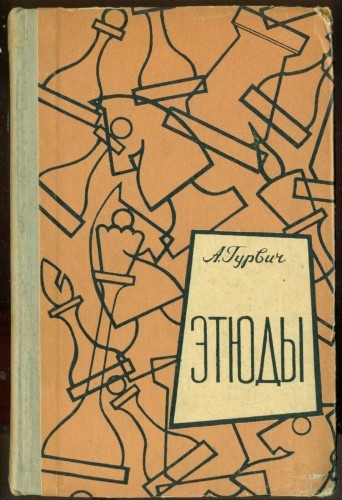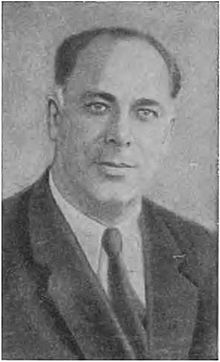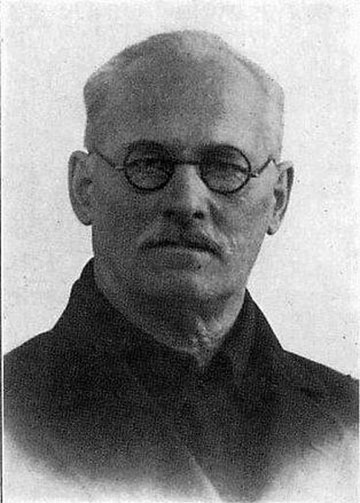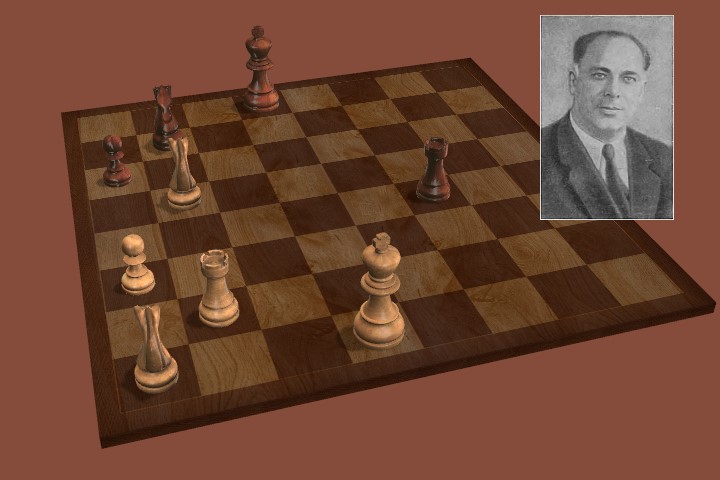Study of the Month: March 2020
A distinct part of German pop culture is the singer Katja Ebstein. Born on 9 March 1945, at we just celebrated her 75th birthday. Among her songs quite a few refer to her passion, theatre, and indeed one of her most famous songs — getting her second place at the Eurovision Song Contest 1980 — is Theater, about clowns wearing their masks for the show and feeling lonely afterwards. Our protagonist would have probably been a fan of the song, had he lived a bit longer.
Theatre, literature, chess composition. Abram Gurvich (12 February 1897 - 18 November 1962) was an expert of it all. Born in Baku, Azerbaijan, Gurvich moved to Moscow to pursue a career as a literary and theatre critic and became a member of the Soviet writers’ guild.
Shortly before the book Meisterwerke der Endspielkunst was printed, Gurvich died, so Dr. Speckmann added a short obituary in the book, quoting the first replayable study below as one of Gurvich’s best works. It won the first prize in Shakhmaty v SSSR 1955 (first semester) and first place at the 4th USSR Championship 1953-1956. The ending reminds me of a widely reprinted Kasparov combination which I include for comparison. Gurvich has 131 endgame studies in the October 2015 database by Harold van der Heijden, including versions, corrections, modifications and co-authored studies.
Speckmann referred to an unnamed article (possibly an obituary), which mentioned that Gurvich’s elaborations were always marked by a polished expression with courageous and surprising thought, as he was the kind of person that could turn complicated, unsettled and unclear productions into harmonious and orderly constructions. Speckmann adds that this holds true not only in his literary works but also in his endgame studies — despite having only published a small number of composed endgames, all of them are of high or very high artistic value.
 Gurvich’s article that would translate to The poetry of chess, the main portion of the book Meisterwerke der Endspielkunst, does not contain a single study by Gurvich, however. Speckmann had translated this long article that served as introduction to the book Soviet Chess Studies (Советский шахматный этюд) — sometimes named Soviet Chess Problems [pictured, right] —that was published in Moscow 1955 by Fizkultura i Sport.
Gurvich’s article that would translate to The poetry of chess, the main portion of the book Meisterwerke der Endspielkunst, does not contain a single study by Gurvich, however. Speckmann had translated this long article that served as introduction to the book Soviet Chess Studies (Советский шахматный этюд) — sometimes named Soviet Chess Problems [pictured, right] —that was published in Moscow 1955 by Fizkultura i Sport.
I will use that article in Speckmann’s translation as a source for Gurvich’s views on endgame studies (also the EG, issue 4, review of the original article), so readers must note that they are from 1955 when Gurvich was in his early 60s. Gurvich’s first studies were published in 1926, so at that time he had been composing for nearly 30 years. Unfortunately, not much information is available to me about Gurvich’s life, so we will mostly concentrate on his views on chess studies. It is of note that Gurvich added the experience from his profession as critic to those views — for example when quoting the writer Vladimir Mayakovsky, a prominent figure of Russian Futurism.
Werner Speckmann (21 August 1913 - 23 February 2001) was President (and honorary President later on) of the German Chess Problem Federation Schwalbe from 1969 to 1982, which he managed to integrate into the general German Chess Federation (Deutscher Schachbund). He composed several thousand chess problems, of which there are over 1700 miniatures (problems with seven or less pieces). Despite his great contribution to chess composition — which can’t all be named here (he wrote numerous articles, books, and other works) — only 18 endgame studies (ca. 15 unique ones) are known by him. He was a civil court judge in the German city of Hamm. At the time of publication of the translation of Gurvich’s article either he or publisher Walter de Gruyter shortened the second half. I translated quotes from the article into English based on Speckmann’s translation.
Gurvich on endgame studies in The poetry of chess
According to the mentioned article The poetry of chess, Gurvich rejected “all that is mechanical, systematized or unnatural” (“P.S.V.”, i.e. Paul Valois, in the editorial of EG, issue 4). Valois understood that Gurvich referred mainly to studies that use a lot of material with fixed pawns and pieces. Such studies violate the rule of strictest economy, Gurvich thought. In addition, he found such studies to be less attractive aesthetically.
As we read in the same editorial, Korolkov replied in his own study collection from 1958, declaring that Gurvich concentrated too much on economy. Kasparyan, in a similar work from 1959, remained neutral. The main composer that disagreed with Gurvich was Alexander Herbstman, who expressed his opinion on the subject in 1964. Valois sided with Kasparyan, noting that each endgame study should be judged on its own merits, rather than generalizing criteria and prejudices.
 In his article, Gurvich states that beauty is a driving force for chess players, with its accompanying joy surpassing all other emotions felt throughout a game. As such, there was great applause when in Russian tourneys a spectacular sacrificial combination ended a game. Arbiters were put at the inner dilemma of having to maintain silence in the room while at the same time being the judges for the beauty prize, a prize that commonly was given to the “most beautiful” chess game in a tourney, independent of the final standings. Usually such a game would then be widely reproduced in the press.
In his article, Gurvich states that beauty is a driving force for chess players, with its accompanying joy surpassing all other emotions felt throughout a game. As such, there was great applause when in Russian tourneys a spectacular sacrificial combination ended a game. Arbiters were put at the inner dilemma of having to maintain silence in the room while at the same time being the judges for the beauty prize, a prize that commonly was given to the “most beautiful” chess game in a tourney, independent of the final standings. Usually such a game would then be widely reproduced in the press.
Gurvich asserts that similarly to the fight between two players, a composer fights with a solver, trying to hide the main point of an endgame study. As there is no opponent that could prevent the combination with his moves, the artistic expression usually is stronger in a composition than in a practical game. In this way of thinking, the “beauty prize” might be a “special” prize for practical players, but is the only kind of prize a composer can strive for. (See the chapter below on theoretical vs. artistic studies for an example chosen by yours truly.)
Starting at page 21 in the book, Gurvich, after comparing and differentiating studies from games, lays out his views. Studies, aiming to open practical players to a permanently active combinatorial mindset, must display a “closed and harmonious picture”. Otherwise it would fade from memory quickly. As Vladimir Mayakovsky wrote, the law of economy is the most important rule for such artistic works. The more empty a board is, Gurvich says, the more difficult it is to constrain them to a mutual dependence, and the easier they can escape attacks, be it direct or indirect ones. As such, it is a sign of high mastery when on a nearly empty board a cunning play by both sides is featured spanning the entire board.
Gurvich believes that studies where pieces only use a small part of the chessboard are usually boring. The position of the later-defeated player should be free from any constraints and seemingly not endangered, Gurvich writes. How, after all, should one gain joy from seeing a one-sided battle where the victor fights against a completely constrained opponent? Following the criteria above, a good study always would seem as if it could come from a practical game and not from a position that seems mechanical or artificial (I would like to add that sometimes positions from practical games can also look artificial or unnatural).
Just as in a normal game a small error can be abused by the opponent and lead to a victory with best play, the intensity and full power of such inherent laws of chess can be transmitted in endgame studies. In this sense, Gurvich preferred works with a natural position and an unusual ending, one that seems as if it could arise from a normal game.
Gurvich quotes Réti and slightly disagrees with his views, as he does not think it is relevant how a composition was conceived: working backwards from the ending, or analysing a light position and adding artistic elements to it. The result, Gurvich argues, is what is important. Yours truly agrees and, as Gurvich elaborates, the Russian School (of chess composition) didn’t restrict composers in their method of composing either. As such, mastery implies that no traces of the composition method are found in the final study. However, Troitzky minted the figurative coin of study composition in Russia for decades. Carried by the successes and findings of the early Russian composers, some found pleasure in showing themes in numerous variations (i.e. different studies): too many, finds Gurvich, in a large number of cases.
 Despite said influence, in the 1920s a new era of composers took over, a feat Troitzky [pictured] himself still witnessed. Alexander Herbstman’s book about the chess study in the USSR was published abroad, with both Euwe and Alekhine praising it. Still, the likes of Troitzky, Platov and Kubbel faced reactions in the form of new composers that had other views about the aesthetics of chess compositions. Gurvich elaborates that while it is easy to find broad rules that apply in general, it is difficult to estimate the application of such rules to each study. Often organic and mechanic elements are mixed in a study, making its evaluation harder. Sometimes advantages and disadvantages of a study are interwoven, or the content and beauty of a study make it necessary to overlook certain aesthetic defects.
Despite said influence, in the 1920s a new era of composers took over, a feat Troitzky [pictured] himself still witnessed. Alexander Herbstman’s book about the chess study in the USSR was published abroad, with both Euwe and Alekhine praising it. Still, the likes of Troitzky, Platov and Kubbel faced reactions in the form of new composers that had other views about the aesthetics of chess compositions. Gurvich elaborates that while it is easy to find broad rules that apply in general, it is difficult to estimate the application of such rules to each study. Often organic and mechanic elements are mixed in a study, making its evaluation harder. Sometimes advantages and disadvantages of a study are interwoven, or the content and beauty of a study make it necessary to overlook certain aesthetic defects.
While all composers follow trends and may experiment with new styles or ideas, a deeper look into different opinions is necessary to find thriving perspectives for endgame studies, Gurvich thinks. He concludes his first chapter mentioning that one needs to detect which directions lead to a dead end.
The second chapter dives deeper into the concepts mentioned above, which I have condensed from around twelve pages. Gurvich gives many studies as examples to elaborate, showing practical applications of his ideas. It would go too far to give minute details, as I hope it became clear to the reader that Gurvich’s thoughts were influenced heavily by his own observations of the greater picture, the development of studies throughout many decades. As such, he merely stated what for many is obvious already, while criticizing studies that do not represent endgames that could have easily appeared in a game. From reading this, however, his views might sound more schematic and dogmatic than they really are.
Two years ago I talked about the Platov brothers. The famous study shown first in that article is also the first study given by Gurvich. He praises the composition, calling it a miracle that White wins. It is, he elaborates, the miracle of logic, the wonderful becoming reality. Both the bishop and knight fulfil the threefold burden, and the vulnerable knight on c1 also unifies the laws of economy and greatest possible coordination.
Let me close the article by showing what Gurvich meant when mentioning that invisible weaknesses can be used to indirectly escape from an attack. This was the seventh study of the book.
White wants to play ♔d3-e4, attacking both Black’s light pieces. However, the rook on h2 is attacked, so it must first escape the attack while winning a tempo. As 1.♖g2+ ♞g5 fails to keep e4 undefended, only 1.♖h7+! ♚f8 suffices.
But now 2.♔e4? ♞g5+ runs into a fork, so 2.♖h8+ ♚xf7 is necessary first.
Black however still has a hidden defence: 3.♔e4? ♞xe5! 4.♔xf4 ♞g6+ and 5.♘xh8 captures the rook.
Instead, White must activate a hidden defence: 3.e6+! ♚xe6 4.♔e4 ♞e5 5.d4! and the attack against knight and rook necessitates 5...♖c4. But what is gained by the intermediate move? In this position ♖c4 pins the d4-pawn — against ♔e4 — which attacks ♞e5 which indirectly protects ♝f4 by threatening to capture the rook on h8, so the rook must attack the king on e6.
After escaping from a position where it was directly threatened into a position where it was indirectly threatened, the rook now moves from the indirectly attacked to the directly attacked square: 6.♖h6+! ♝xh6. A mid-board stalemate follows, a completely unexpected resource after taking a first glance at the initial position. With four pieces that can move and an only slightly inconvenienced king, stalemate seemed far away, yet arose logically from the battle, with all six pieces moving into their final position.
Examples: Theoretical vs. artistic studies
Werner Speckmann added that there are also “endgame studies” in the truer sense of the word, such that are not artistic but rather theoretical or analytical endgames, found in every endgame book, that is, endgames that the learning player needs to study. I want to add that, while it is not necessary, they can in addition have artistic elements that make them easier to remember, such as “building a bridge” in the endgame of KRP-KR where a rook moves to the fourth/fifth rank to protect the king from checks and ensure promotion. Please see the diagrams.
Example for a theoretical endgame study. White wins by “building a bridge”. Lucena’s solution is 1.♖d4 ♜a2 2.♔c7 ♜c2+ 3.♔b6 ♜b2+ 4.♔c6 ♜c2+ 5.♔b5 ♜b2+ 6.♖b4 and White wins. 1.♖d5 wins similarly here, but with the black king on e6 instead White would need to play 1.♖d4 to make progress.
Black was to move and draw with 1...♜d6+ 2.♔b5 ♜d5+ 3.♔b4 ♜d4+ 4.♔b3 ♜d3+ 5.♔c2 ♜d4!! 6.c8♕ ♜c4+ 7.♕xc4 stalemate. While the study looks like an endgame and the manoeuvre has theoretical value, it is primarily artistic, more so after a solver, Reverend Saavedra, found a “cook” (a way for the other side to prevent the intended outcome) that was better than the solution: 6.c8♖!! ♜a4 (what else?) 7.♔b3! wins. So the study was printed again with Saavedra’s name added and the caption “Black to move, White wins”.
Later, the pawn from c7 was moved to c6, so White was to move and win. The complete story was discovered by John Selman and can for example be found on Tim Krabbé’s Chess Curiosities website, which sadly receives few updates nowadays. Like many good artistic studies, we also experience a battle of the wits here, but only very rarely (as was the case here) is the solver the one finding such a witty idea that he become the co-author of the study.
[The second to last study is not completely sound, as pointed out by Geir Sune Tallaksen — he wrote: "I discovered this a few months ago when I was planning to show the study myself, I just haven't been sure about where to report it now that EG no longer has an errata column. Instead of 2.Qf2, it turns out that 2.Qxd3 is an EGTB win. QNN vs QN is normally a draw, but apparently Black's pieces are so badly placed that this position is a win. This can be easily corrected by moving Nb4 to b2 and letting Black play 1...Nd1 instead of 1...Nd3. This makes Black's first move a bit less impressive, but at least the study is sound. I have tried to improve on this with a different introduction, without success so far." - Ed.]
Click or tap an entry in the list to switch positions
You probably know that you can move pieces on our replay boards to analyse and even start an engine to help you. You can maximize the replayer, auto-play, flip the board and even change the piece style in the bar below the board.
At the bottom of the notation window on the right there are buttons for editing (delete, promote, cut lines, unannotate, undo, redo) save, play out the position against Fritz and even embed the ChessBase game viewer on your website or blog. Hovering the mouse over any button will show you its function.
Perfect endgame analysis and a huge increase in engine performance: Get it with the new Endgame Turbo 5! This brings the full 6-piece Syzygy endgame tablebases on a pendrive. Just plug it in a USB socket and you are set!

World Federation for Chess Composition (www.wfcc.ch)
Links


















 Gurvich’s article that would translate to The poetry of chess, the main portion of the book Meisterwerke der Endspielkunst, does not contain a single study by Gurvich, however. Speckmann had translated this long article that served as introduction to the book Soviet Chess Studies (Советский шахматный этюд) — sometimes named Soviet Chess Problems [pictured, right] —that was published in Moscow 1955 by Fizkultura i Sport.
Gurvich’s article that would translate to The poetry of chess, the main portion of the book Meisterwerke der Endspielkunst, does not contain a single study by Gurvich, however. Speckmann had translated this long article that served as introduction to the book Soviet Chess Studies (Советский шахматный этюд) — sometimes named Soviet Chess Problems [pictured, right] —that was published in Moscow 1955 by Fizkultura i Sport. In his article, Gurvich states that beauty is a driving force for chess players, with its accompanying joy surpassing all other emotions felt throughout a game. As such, there was great applause when in Russian tourneys a spectacular sacrificial combination ended a game. Arbiters were put at the inner dilemma of having to maintain silence in the room while at the same time being the judges for the beauty prize, a prize that commonly was given to the “most beautiful” chess game in a tourney, independent of the final standings. Usually such a game would then be widely reproduced in the press.
In his article, Gurvich states that beauty is a driving force for chess players, with its accompanying joy surpassing all other emotions felt throughout a game. As such, there was great applause when in Russian tourneys a spectacular sacrificial combination ended a game. Arbiters were put at the inner dilemma of having to maintain silence in the room while at the same time being the judges for the beauty prize, a prize that commonly was given to the “most beautiful” chess game in a tourney, independent of the final standings. Usually such a game would then be widely reproduced in the press.  Despite said influence, in the 1920s a new era of composers took over, a feat Troitzky [pictured] himself still witnessed. Alexander Herbstman’s book about the chess study in the USSR was published abroad, with both Euwe and Alekhine praising it. Still, the likes of Troitzky, Platov and Kubbel faced reactions in the form of new composers that had other views about the aesthetics of chess compositions. Gurvich elaborates that while it is easy to find broad rules that apply in general, it is difficult to estimate the application of such rules to each study. Often organic and mechanic elements are mixed in a study, making its evaluation harder. Sometimes advantages and disadvantages of a study are interwoven, or the content and beauty of a study make it necessary to overlook certain aesthetic defects.
Despite said influence, in the 1920s a new era of composers took over, a feat Troitzky [pictured] himself still witnessed. Alexander Herbstman’s book about the chess study in the USSR was published abroad, with both Euwe and Alekhine praising it. Still, the likes of Troitzky, Platov and Kubbel faced reactions in the form of new composers that had other views about the aesthetics of chess compositions. Gurvich elaborates that while it is easy to find broad rules that apply in general, it is difficult to estimate the application of such rules to each study. Often organic and mechanic elements are mixed in a study, making its evaluation harder. Sometimes advantages and disadvantages of a study are interwoven, or the content and beauty of a study make it necessary to overlook certain aesthetic defects.





